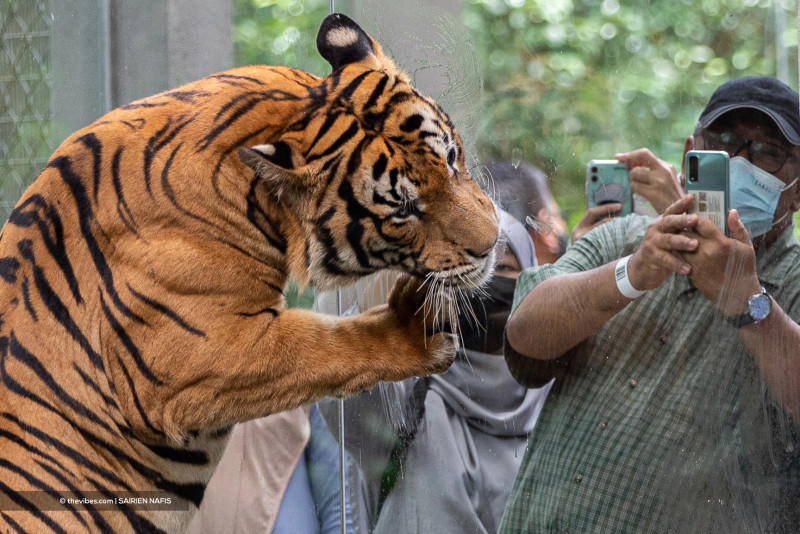WWF-MALAYSIA is deeply saddened by the recent tragic incident in Kg Sau, Gua Musang, where Anek Along, a 59-year-old Orang Asli villager, was attacked and killed by a tiger. We extend our deepest condolences to the family of the deceased. We are also devastated that the tiger had to be shot, despite it being a critically endangered species that we as a nation are committed to protecting at all cost. We share our concern for the safety of the villagers, and urge that best practices and necessary steps be taken to avoid further casualty, be it man or beast.
Unfortunately, incidents of human-tiger conflict (HTC) are not uncommon in tiger range countries. HTC occurs when a wild tiger interacts with humans, their animals or their livestock and results in an injury or death to a human, livestock or tiger.
In Russia, two wild tigers responsible for killing three dogs on the outskirts of the town Vyazemskoye were sedated and successfully relocated to the Utyos Rehabilitation Centre with the support of WWF-Russia and ANO Amur Tiger.
In Bhutan, human-wildlife conflict is a critical issue as farming communities reside close to protected areas or in reserved forests. Apart from measures such as the use of sound and light repellent and electric fencing, “Safe Systems” is being adopted to address this issue holistically with strategies that ensure the safety of both humans and wildlife.
In Peninsular Malaysia, our forests are home to fewer than 200 tigers, yet in recent months, a few from this already dwindling population have ventured out of the forest, closer to human settlements. With increased incidences, there is a real urgency to find a holistic way to address and manage HTC. To do this, we must understand the nature of the tiger, the possible causes leading to HTC and expedite necessary solutions.
Individual tigers require a large territory, and the size of its territory is determined mostly by the availability of prey. Across their ranges, tigers face unrelenting pressures from poaching, retaliatory killings, and habitat loss. They are forced to compete for space with dense and often growing human populations.

Tigers are by nature solitary, unless they are courting or a mother with young cubs. Preferring to shy away from humans, the tiger hunts alone, by ambush, waiting for lone, unsuspecting prey. A tiger when threatened or already injured may exhibit more aggression and its natural behaviour is to defend and save itself.
The solution is to minimise contact between wild tigers and humans. However, as competition for space and habitat increases, this becomes a challenge. It is only a matter of time before its numbers are completely wiped out from the combined threat of poaching, deforestation, habitat loss, lack of natural prey, injuries from snares or being hunted, leading to the inability to hunt for food as in the case of Awang Rasau (tiger that died in March last year after being shot by poachers), increased incidences of HTC, and the threat of disease such as canine distemper.
When we stop threatening the resources required for a self-sustaining ecosystem, the coexistence between human and wildlife can be better managed. As we work towards increasing our wild tiger numbers, we also need to look at effectively managing HTC for the safety of the communities that live close to the forest as well as the conservation of the Malayan tiger.
Year 2021 had closed on a hopeful note with the announcement of starting a Wildlife Crime Unit by the police. Energy and Natural Resources Minister Datuk Seri Takiyuddin Hassan had also announced the establishment of a National Tiger Task Force and a Tigers Working Group to look at ways to increase tiger population in the wild. Along with other NGOs, we have advocated for several years to see this achieved, and now we must quickly and relentlessly move forward with the next phase of implementation – the nine strategic actions for the conservation of the species approved by the cabinet in June last year.
The Malayan tiger is already standing precariously close to the brink of extinction. We may be losing tigers faster than they can breed. With fewer tigers, the chances of breeding will be further reduced, and with so few remaining in the wild, the urgency to conserve each and every tiger is so critical.
In a few weeks, as we usher in the Year of the Tiger, my hope is that every Malaysian will seek to understand the nature and necessary existence of this critically endangered species – our national icon – and its connection to our very own survival. – The Vibes, January 10, 2022
Sophia Lim is executive director and chief executive officer of WWF-Malaysia


















.jpg)

